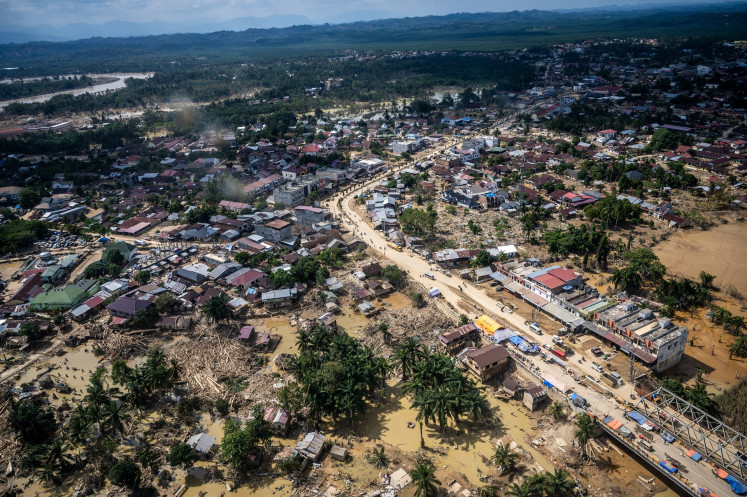Popular Reads
Top Results
Can't find what you're looking for?
View all search resultsPopular Reads
Top Results
Can't find what you're looking for?
View all search resultsRI ready to add LNG supply to Japan
Indonesia is ready to provide additional liquefied natural gas (LNG) to Japan to meet the expected surge in gas use following the shutdown of the country’s several nuclear power plants
Change text size
Gift Premium Articles
to Anyone
I
ndonesia is ready to provide additional liquefied natural gas (LNG) to Japan to meet the expected surge in gas use following the shutdown of the country’s several nuclear power plants.
BPMigas spokesman Gde Pradnyana said on Monday that Japan might turn to Indonesia to meet the surge in the country’s gas needs to generate electricity to compensate for the decline in the power supply from nuclear reactors.
He said that 20 cargoes of LNG from the Bontang Plant in East Kalimantan were still available for sale. At present, Japan is one of the main buyers of LNG produced at the Bontang Plant.
Tokyo Electric Power Corp. and other Japanese utilities may increase outputs of gas, oil and coal-fired power plants to replace production from the 11 nuclear reactors closed last week following the 8.9-magnitude earthquake that hit on Friday. About 30 percent of Japan’s power supply comes from 54 nuclear reactors.
“Japan lost around 25 percent of its power supply following the disaster. As the crude oil price is more expensive now, it will buy more gas to generate electricity,” he said, adding that the recovery of the nuclear plant was predicted to take a long time.
Gde said that so far shipments of LNG to Japan had not been interrupted following the devastation.
Indonesia is the world’s second largest LNG producer with most of its production coming from three plants — the Arun Plant in Aceh, Bontang Plant in East Kalimantan and Tangguh Plant in Papua.
BPMigas said recently that Indonesia would need to import up to 4.5 million tons of LNG every year beginning in 2013 in order to meet the surging domestic demand. Nearly half of the total gas produced in the country last year was exported, mostly in the form of LNG produced at the country’s three LNG plants.
Japan is Indonesia’s largest LNG buyer followed by South Korea and Taiwan. BPMigas said Indonesia’s shipments of LNG to Japan would likely fall to 172 cargoes this year from 258 cargoes last year.
Analysts estimated that low-sulfur crude and fuel oil shipments from Indonesia and Sudan might rise as Japan imports oil to burn in power plants after shutting nuclear reactors following the massive earthquake.
“On a nationwide basis, the additional crude oil burned for power generation should result in an increase of close to 300,000 barrels a day from recent levels,” said Olivier Jakob, managing director of Switzerland-based researcher Petromatrix GmbH in a note on Monday.
This should “provide some strong support” to Indonesian crude, he told Bloomberg.
Japan’s imports of Indonesia’s Minas and Duri crude and Sudan’s Nile Blend surged to exceed 200,000 barrels a day after nuclear plants shut in July 2007 following an earthquake, according to data from Vienna-based consultants JBC Energy GmbH.
Electricity producers turned to low-sulfur crudes and fuel oils to burn in generators as an alternative after Tokyo Electric Power Co. shut the Kashiwazaki-Kariwa facility, the world’s largest at 8,200 megawatts, for 21 months after the 2007 earthquake.
Minas, Duri and Nile Blend are considered denser than alternative varieties and able to ignite at relatively lower temperatures.
“The loss of the power plant had a massive impact on Japanese demand for heavy-sweet Duri and lighter direct-burning grades such as Minas and Nile Blend,” JBC Energy consultants said in their weekly Asian report.
“Following the latest nuclear plant outage, we would expect the demand for low-sulfur waxy grades to increase in the coming months,” he said as reported by Bloomberg
Torbjoern Kjus, oil market analyst at Oslo-based bank DnB NOR, said “The immediate direct effect on incremental oil demand for power generation will probably be about 150,000-200,000 barrels a day,” consisting of light-sweet crude for direct burning and low-sulfur fuel oil, assuming the grid is still able to distribute power. (lnd)









